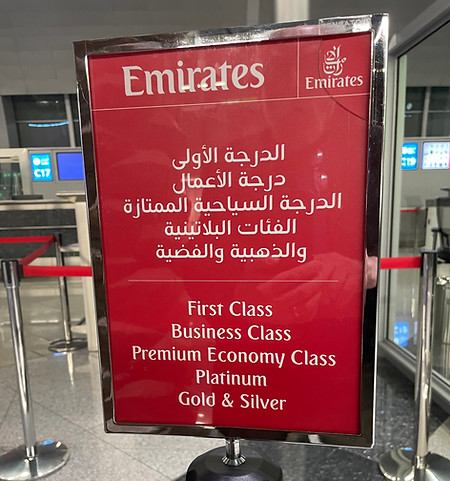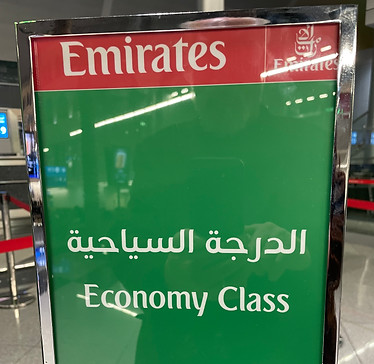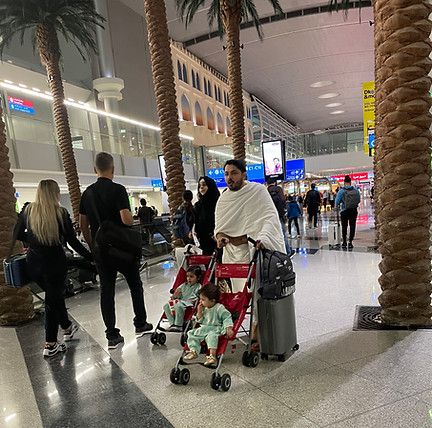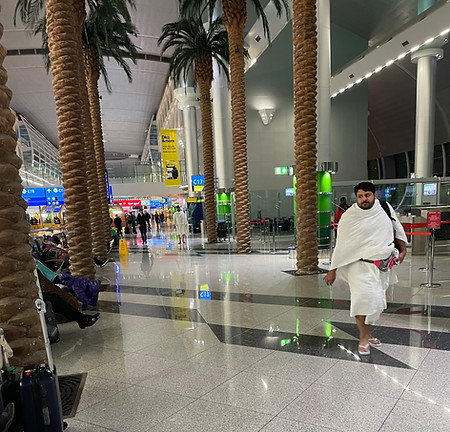Never Miss a New Post.

The plane ride from Seattle was long, hot, and unconfortable. Boeing jets in general and Boeing jumbo jets in particular are in my opionion less comfortable the Airbus jets. Their corporate approach seems to build as cheaply as possible so that their customers can make as much money as possible.
Like every other airline, Emirates has multiple class - first class (curtained off from the other, lower classes), business, premium economy, pltinum, gold and silver, and economy. They all have wider seats, more leg room, seats that recline more (some almost recline into beds), better food, and who knows what else in first class. And of course you pay for that, significantly in the top tiers.
Starting out
There are no direct flights to Nairobi. The best choice of airline seems to be Emirates, which takes you first to Dubai, and after a layover, on to Nairobi. From Seattle you leave in late afternoon and arrive in Dubai the next day at about the same (local) time. After a seven hour layover you leave in the very early morning to arrive in Nairobi the next day for breakfast. So you leave Seattle and two days later you're in Kenya. Total flying time is just under 20 hours.
In Flight

The plane ride from Seattle was long, hot, and unconfortable. Boeing jets in general and Boeing jumbo jets in particular are in my opionion less comfortable than Airbus jets. Their corporate approach seems to build as cheaply as possible so that their customers can make as much money as possible.
Like every other airline, Emirates has multiple classes - first class (curtained off from the other, lower classes), business, preferred traveler, economy plus, and economy. They all have wider seats, more leg room, seats that recline more (some almost recline into beds), better food, and who knows what else in first class. And of course you pay for that, significantly in the top tiers.
In economy, the seats are narrow and unconfortable, in any position. Reclining brings the seat back 4 inches at most, and the hinge seems to be an inch or two above the seat, so that you have a ridge pokeing you in the lower back. I used the pillow they give to make it tolerable, but it still was not a seat I would like to have in my house.
And the meals are different. The quality of the food is better than you get on an American airline, but it's like the difference between a Marie Collander's frozen dinner and a Safeway chicken pot pie. And the seats (in economy class) are so narrow that your elbow can end up in your neighbor's plate. I was in the middle seat of my row, so I tried not to unduly inconvenience the woman in the window seat. Luckily the guy in the aisle seat was left-handed.

Dubai
The Dubai airport is amazing. Looks like it was built within the last five years. Immaculately maintained, mainly white and chrome, with three-story vaulted halls. And with every high-dollar store you see in the West - Gucci, Armani, duty-free stores with $700 bottles of Scotch whiskey and French perfume, as well as Starbucks and hamburger-and-hotdog stands.




And a great place to people watch. Some Europeans, but mostly Middle Eastern, with significant numbers of Africans, Indians, and Asians. I even saw a guy who looked like Jesus Christ, with long white robes, sandals, a beard, and a head covering resembling a hoody.


Arriving in Nairobi
The Nairobi airport was a real surprise, especially in comparison with the Dubai airport. I would have thought that a nation would want the airport of its capital city to present an image of modernity and technical accomplishment. Perhaps the departure section does that, or perhaps they are rebuilding the airport, but the arrival area was anyting but modern.
We disembarked onto a walkway into the terminal, but almost immediately went down a flight of stairs to the tarmac. From there we walked a short distance to a shed with no walls (like a very large carport ) where they checked our COVID status. Either a basic vaccine or a negative test in the last 72 hours is required to enter Kenya.
Next we proceded to immigration, another carport-like structure with four different queues - one for Kenyan citizens, one for citizens of the East African Community (Democratic Republic of the Congo, the United Republic of Tanzania, the Republics of Kenya, Burundi, Rwanda, South Sudan, and Uganda), one for citizens of other African states, and one for everyone else. Once I worked my way to the front of the line, the officer glanced at my passport and visa, asked me what I planned to do in the country, and then waved me through to the baggage room.
The baggage claim was complete chaos, a large room with three carousels to handle all international flights. When you consider that most international flights are jumbo jets with 200+ passengers, you can imagine the problems. Lucy had told me to find some guys in yellow safety vests to help me find my bags and get them through customs, so I grabbed the first guy who was free. (These are freelancers who the authorities let in to help passengers, so you tip then $10 dollars for the service.) The guy I grabbed help me go through the hundreds of suitcases to find mine, while his partner looked for a cart to put them on.
The exit to the parking lot and pickup area was a double door with customs (two customs officers and a long table) on either side of the door. Many people were simply waved through, but if they decided to check someone the line solowed down, and if both pairs of officers were checking bags, the line stopped completely. Finally I was waved through, found Lucy, got the bags to the car and we headed to Lucy's house in the suburbs.
The Kenyans
Kenyans are very sociable, almost communal. Think of African Americans, who often greet each other with high fives, fist bumps, and What's happening?, How ya doing, brother?, How's your family?, etc. Even if they don't know each other, they almost always offer some sort of acknowledgement. Multiply that by five and you have Kenyans.
A good illustration of this is my experience with Lucy last week. We had gone to the nearest branch of her bank so that she could withdraw some cash for incidental expenses. The branch was on the main street, with angled-in parking on the street.
After she got her cash and got into the car, she started to back out, looking over her shoulder for an opening in the traffic. Unfortunately she cranked her steering wheel too far and ended up scraping the back door of the car next to hers. So Lucy drove back into the space and got out to have a look.
Immediately a crowd formed on the sidewalk and started discussing the situation. Most offered a comment and moved on, some stayed to discuss the situation and how it should be resolved, and eventually there were 10 or more people who took an active interest in seeing it through to the end.
"Did you see that? She crashed right into that car!"
"It's only a minor scratch."
"To you, but what if it was your car?"
"It would still be a minor scratch."
"Anyone know whose car that is?"
"I know her, she's in the bank. I'll go get her."
"She should have been more careful."
"So you've never scraped another car?"
[Side note: There are almost no cars in Kenya without at least a few scratches or dents; more on Kenyans' driving habits later.]
"Look, there's a mzugu (white guy) in the car. "
"He's probably her husband."
"So what, he wasn't driving."
"But if he's her husband he can afford to pay."
"Maybe he was trying to help her and she didn't listen to him."
"If she's Kikuyu [the local ethnic group] she definitely wouldn't listen to him.
At this point a lot of the men (Kikuyus, I assume) started laughing, and some of the women were acting offended. Luckily the woman who owned the car that Lucy scratched came out at this point.
Lucy apologized and offered a small sum as compensation for the damage. The other woman countered with a much larger sum, Lucy counter-offered with a slightly larger figure. They went back and forth for a while, and at a certain point the woman threatened to involve the police. (All this with commentary and advice from the crowd on the sidewalk.)
Lucy pointed out that to involve the police, who had not witnessed the incident, they would both have to go to the nearest station, each give a statement, and wait for the police to issue a report. That would probably take the rest of the morning, and could even take the rest of the day.
In the end Lucy gave the woman 2,000 Kenyan shillings (about $12.50 US, the woman went back into the bank, and the crowd offered a last round of comments and dispersed.